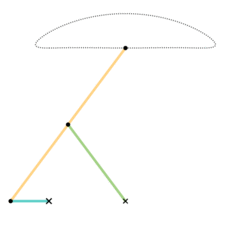Engineering:Chebyshev lambda linkage

Dimensions (unit length a):


In kinematics, the Chebyshev Lambda Linkage[1] is a four-bar linkage that converts rotational motion to approximate straight-line motion with approximate constant velocity.[2] It is so-named because it looks like a lowercase Greek letter lambda (λ).[3] The precise design trades off straightness, lack of acceleration, and the proportion of the driving rotation that is spent in the linear portion of the full curve.[4]
The example to the right spends over half of the cycle in the near straight portion. Coupler (link 3) point stays within 1% positional tolerance with intersecting the ideal straight line 6 times.
The linkage was first shown in Paris on the Exposition Universelle (1878) as "The Plantigrade Machine".[5][3] The Chebyshev Lambda Linkage is a cognate linkage of the Chebyshev linkage.
The Chebyshev Lambda Linkage is used in vehicle suspension mechanisms, walking robots and rover wheel mechanisms. In 2004, a study completed as a Master of Science Thesis at Izmir Institute of Technology introduced a new mechanism design by combining two symmetrical Lambda linkages to distribute the force evenly on to ground with providing the straight vertical wheel motion.[6] It was then designed, manufactured and tested in the Earth Rover Project of Los Angeles City College Electronics Club.[7]
See also
- Chebyshev linkage, the cognate of the Chebyshev lambda linkage.
- Hoeckens linkage, a linkage that produces a very similar locus using one less link but an additional slider.
- Leg mechanism
- Straight line mechanism
References
- ↑ "Chebyshev's Lambda Mechanism – Wolfram Demonstrations Project". http://demonstrations.wolfram.com/ChebyshevsLambdaMechanism/.
- ↑ Design of Machinery. 2011. http://www.designofmachinery.com/DOM/.
- ↑ 3.0 3.1 "Tchebyshev's plantigrade machine — Mathematical Etudes". Archived on 2017-07-28. Error: If you specify
|archivedate=, you must also specify|archiveurl=. https://etudes.ru/en/etudes/chebyshev-plantigrade-machine/. Retrieved 2014-11-16. - ↑ DOM p134 Hoecken linkage. http://www.designofmachinery.com/DOM/Chap_03_3ed_p134.pdf.
- ↑ "Dzenushko Dainis: Walking mechanisms survey – Department of Theoretical and Applied Mechanics". http://mech.spbstu.ru/Dzenushko_Dainis:_Walking_mechanisms_survey#The_Chebyshev_Walking_Mechanism.
- ↑ Barlas, Fırat (June 2004). "Design of a Mars Rover suspension mechanism". Izmir Institute of Technology. https://openaccess.iyte.edu.tr/xmlui/handle/11147/3449.
- ↑ (in en) Moxie Video Intro It, https://vimeo.com/117774490, retrieved 2022-11-17
External links
- Hoeckens approximate straight-line mechanism (diagram and table of lengths)
- Hoeckens straight line linkage (Homemade example)
- Video of computer simulation of Tchebychev walking machine (Стопоход Чебышева).
- alexdenouden.nl – Rectilinear motion after "Tchebychev"
- A simulation using the Molecular Workbench software
- How does a Hoecken's Linkage Work? (Interactive Flash Animation)
 |
